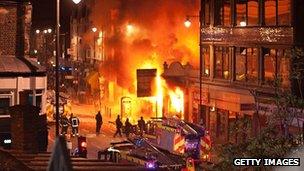England riots lead to 1,500 convictions so far
- Published

Rioting: More than 2,700 before the courts so far
More than 1,500 people have been convicted of crimes relating to the riots in English cities last summer.
Statistics published by the Ministry of Justice show offenders were three times more likely to be jailed by magistrates than other criminals.
The average length of all sentences was longer than for other crimes at just over 14 months.
Justice Minister Crispin Blunt said the "swift and firm" justice handed down by the legal system helped stop the riots.
Figures also show 41% of defendants, where their background was stated, were white and 39% from a black background.
The fresh statistics follow figures from last autumn showing that those who joined in were poorer and younger, with a lower educational record than the average in England.
According to the new figures, external, as of midday on 1 February, 2,710 people had appeared before courts across England charged with offences relating to the disturbances between 6th and 9th August.
Almost 1,900 defendants have appeared in London courts, followed by 301 in the West Midlands, 240 in Greater Manchester, 92 in Merseyside, 64 in Nottingham and 117 in other areas.
'Violent disorder'
Almost half of all the defendants had been charged with burglary and a fifth with violent disorder, a crime which is similar to the more serious offence of rioting. Some 16% had been charged with theft.
Some 1,519 have been convicted so far - more than half of all those who have appeared. Almost all of those have been sentenced - and more than 60% were immediately jailed. The average sentence of 14.2 months is almost four times longer than sentences for similar offences in 2010.
The figures show that offenders who have been dealt with by magistrates have been four times more likely to go to jail than those who were dealt with in the previous year.
The figures also show:
89% of all defendants are male, comparable with typical crime rates
27% were between 10 and 17 years old
26% were between 18 and 20 years old
Almost 40% of defendants in Nottingham and Merseyside were juveniles
Updated figures for ethnicity show that 41% of defendants, where their background was stated, were white, 39% from a black background and 12% were mixed. Some 6% were Asian and 2% were defined as Chinese or other.
Previous figures from the government have shown that approximately 13% of those involved in the disturbances were defined as gang members and three-quarters of all those who had appeared in court had a previous conviction or caution.
More than 2,500 shops and business were attacked by looters and vandals, along with a further 230 homes.
Mr Blunt paid tribute to the legal system saying: "The courts, judges and the probation and prison services have worked hard to make sure that those who attacked their own communities during the public disorder last August have faced justice quickly.
"They played a key part in stopping the riots from spreading further by delivering swift and firm justice, and these statistics make clear that the disgraceful behaviour innocent communities endured last summer is wholly intolerable."